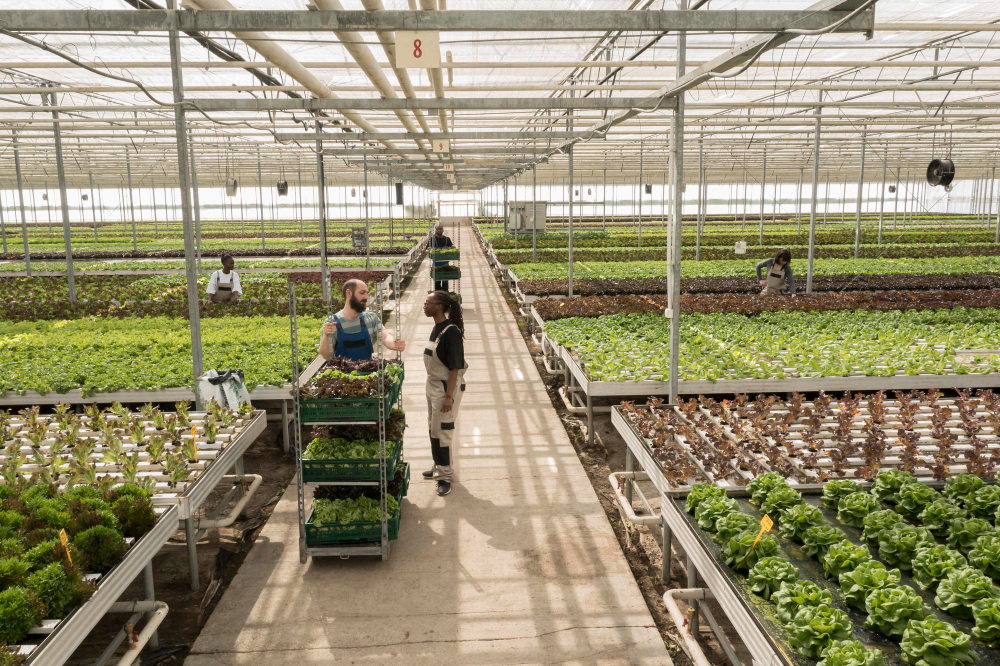Last updated on
In the landscape of agriculture, the emergence of commercial greenhouses stands as a beacon of innovation, ushering in a new era of sustainable and efficient farming practices. As traditional farming methods face challenges posed by climate change, resource depletion, and the growing global population, commercial greenhouses are proving to be a revolutionary solution.
These controlled environments, equipped with advanced technology, allow farmers to overcome traditional limitations and cultivate crops in an optimized and eco-friendly manner. In this article, we delve into the transformative impact of commercial greenhouses on modern agriculture, exploring their benefits, technological advancements, and the potential they hold for a more sustainable food future.
Year-round Production and Crop Diversification

One of the primary advantages of commercial greenhouses is their ability to enable year-round production of crops, independent of external weather conditions. Traditional agriculture often grapples with the unpredictability of climate, making it challenging to maintain consistent crop yields.
Commercial greenhouses, however, provide a controlled environment where temperature, humidity, and light levels can be precisely regulated. This control not only extends the growing season but also allows farmers to experiment with a wider variety of crops that may not thrive in their native climates.
This flexibility promotes crop diversification, reducing the dependence on a few staple crops and enhancing overall food security.
Resource Efficiency and Sustainable Practices
Commercial greenhouses are designed with resource efficiency at their core, addressing some of the pressing challenges associated with conventional farming. These structures minimize water usage through advanced irrigation systems, utilizing recirculation techniques that reduce wastage.
Additionally, controlled environments enable the optimal use of fertilizers and pesticides, mitigating the environmental impact associated with their excessive application in open fields. The integration of renewable energy sources, such as solar panels, further contributes to the sustainability of greenhouse operations.
As a result, commercial greenhouses not only produce higher yields but also do so with a reduced ecological footprint, aligning with the global shift towards environmentally conscious agricultural practices.
Precision Farming Technologies

The technological advancements within commercial greenhouses are reshaping the landscape of precision farming. Automated systems, sensor networks, and artificial intelligence are being leveraged to monitor and control various aspects of greenhouse environments.
These technologies enable farmers to fine-tune conditions for optimal plant growth, from adjusting humidity levels to controlling nutrient delivery. Moreover, data analytics play a crucial role in decision-making, providing insights into crop health, predicting potential issues, and optimizing resource allocation.
The integration of these technologies not only enhances productivity but also empowers farmers with valuable insights, paving the way for a more intelligent and efficient approach to agriculture.
Commercial Greenhouse for Sustainable Farming
As the popularity of commercial greenhouses continues to rise, farmers are faced with the crucial decision of selecting the right structure for their specific needs. When choosing a commercial greenhouse, factors such as design, materials, and technology integration play a pivotal role in determining its effectiveness in promoting sustainable farming practices.
Opting for energy-efficient designs, utilizing recycled materials, and selecting greenhouse management systems that prioritize resource conservation are essential considerations. Furthermore, farmers must assess the scalability of the greenhouse to ensure it aligns with their production goals.
The careful selection of a commercial greenhouse not only enhances the overall efficiency of farming operations but also contributes to the broader goal of building a resilient and sustainable agricultural ecosystem.
Adapting to Climate Change Challenges
Commercial greenhouses play a crucial role in mitigating the impacts of climate change on agriculture. With unpredictable weather patterns becoming increasingly common, these controlled environments provide a shield against extreme conditions such as droughts, floods, and temperature fluctuations.
Through advanced climate control systems, farmers can create optimal conditions for crop growth, safeguarding their investments and ensuring a more stable food supply. This adaptability is paramount in the face of climate change challenges, making commercial greenhouses a strategic investment for a resilient and climate-resilient agricultural future.
Economic Viability and Market Access
Beyond their environmental benefits, commercial greenhouses offer a compelling case for economic viability and market access. By providing a consistent and reliable supply of crops throughout the year, farmers can tap into off-season markets, securing higher prices for their produce.
Additionally, the controlled environment allows for the cultivation of high-value crops, further enhancing the economic returns on greenhouse investments. The ability to produce premium crops consistently not only strengthens the financial viability of farming operations but also creates opportunities for farmers to diversify their income streams, contributing to the overall sustainability of the agricultural sector.
The rise of commercial greenhouses represents a pivotal moment in the evolution of agriculture, offering a multifaceted solution to the challenges faced by traditional farming methods. From ensuring year-round production and promoting crop diversification to integrating advanced technologies for precision farming, these structures embody sustainability and efficiency.
When choosing a commercial greenhouse, farmers must carefully consider factors such as design, materials, and technology integration to maximize their benefits. As we navigate the complexities of climate change, economic viability, and market dynamics, commercial greenhouses stand as beacons of innovation, pointing the way toward a more resilient, sustainable, and prosperous future for global agriculture.
Table of Contents




